The list of Kriegsmarine ships includes all ships commissioned into the Kriegsmarine, the navy of Nazi Germany, during its existence from 1935 to the conclusion of World War II in 1945.
See the list of naval ships of Germany for ships in German service throughout the country's history.
Capital ships
Pre-dreadnought battleships
| Class | Displacement (standard) | Main battery | Speed | Ship | Image | Commis- sioned | Fate |
|---|---|---|---|---|---|---|---|
| Deutschland class | 15,000 tons | 4 × 11-in. | 18 kn | Hannover |  | Oct 1907 | Scrapped between 1944 and 1946 |
| 19.1 kn | Schleswig-Holstein | 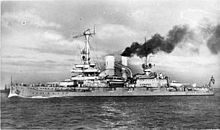 | Jul 1908 | Scuttled, Mar 1945 | |||
| 18.5 kn | Schlesien |  | May 1908 | Mined off Swinemünde in May 1945 |
Modern battleships
| Class | Displacement (standard) | Main battery | Speed | Ship | Image | Commis- sioned | War loss |
|---|---|---|---|---|---|---|---|
| Bismarck class | Bismarck: 41,700 tons Tirpitz: 42,900 tons | 8 × 15-in. | 30 kn | Bismarck |  | Aug 1940 | Scuttled following incapacitating battle damage, May 1941 |
| Tirpitz |  | Feb 1941 | Sunk by air attack, Nov 1944 | ||||
| Scharnhorst class | 32,100 tons | 9 × 11-in. | 31 kn | Scharnhorst | 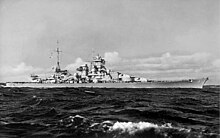 | Jan 1939 | Sunk by gunfire, Dec 1943 |
| Gneisenau |  | May 1938 | Sunk as a blockship, Mar 1945 |
Cruisers
Heavy cruisers
| Class | Displacement (standard) | Main battery | Speed | Ship | Image | Commis- sioned | War loss | Postwar |
|---|---|---|---|---|---|---|---|---|
| Deutschland class | 14,290 tons | 6 × 11-in. | 28 kn | Deutschland; renamed Lützow Jan 1940 |  | Apr 1933 | Air attack Baltic Sea, Apr 1945 | |
| Admiral Scheer |  | Nov 1934 | Air attack Kiel, Apr 1945 | |||||
| Admiral Graf Spee | 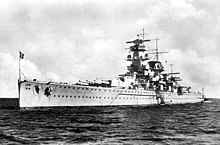 | Jan 1936 | Scuttled Montevideo, Dec 1939 | |||||
| Admiral Hipper class | 18,200 tons | 8 × 8-in. | 32 kn | Admiral Hipper |  | Apr 1939 | Scuttled Kiel, May 1945 | |
| Blücher |  | Sep 1939 | Sunk Drøbak Sound, Apr 1940 | |||||
| Prinz Eugen | 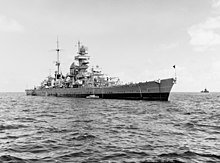 | Aug 1940 | Prize of US |
Light cruisers
| Class | Displacement (standard) | Main battery | Speed | Ship | Image | Commis- sioned | War loss | Postwar |
|---|---|---|---|---|---|---|---|---|
| Emden | 6,990 tons | 8 × 5.9-in. | 29.5 kn | Emden |  | Oct 1925 | Scuttled Heikendorf, May 1945 | |
| Königsberg class | 7,700 tons | 9 × 5.9-in. | 32 kn | Königsberg |  | Apr 1929 | Air attack Bergen, Apr 1940 | |
| Karlsruhe |  | Nov 1929 | Scuttled off Kristiansand, Apr 1940 | |||||
| Köln |  | Jan 1930 | Air attack Wilhelmshaven, Mar 1945 | |||||
| Leipzig class | 8,900 tons** | 9 × 5.9-in. | 32 kn | Leipzig |  | Oct 1931 | Scuttled, Jun 1946 | |
| Nürnberg | 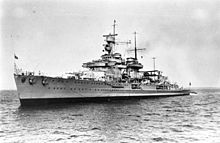 | Nov 1935 | Prize of USSR |
Destroyers and torpedo boats
Named destroyers
| Class | Displace- ment | Torpedo load | Speed | Image | Ship | War loss | Postwar |
|---|---|---|---|---|---|---|---|
| Type 1934 destroyers | 3,155 tons | 8 × 21-in. | 36 kn |  | Z1 Leberecht Maass | Sunk, Feb 1940 | |
| Z2 Georg Thiele | Beached, Apr 1940 | ||||||
| Z3 Max Schultz | Sunk w all hands, Feb 1940 | ||||||
| Z4 Richard Beitzen | Scrapped, 1949 | ||||||
| Type 1934A destroyers | 2,270 tons | 8 × 21-in. | 36 kn |  | Z5 Paul Jakobi | Scrapped, 1954 | |
| Z6 Theodor Riedel | Scrapped, 1958 | ||||||
| Z7 Hermann Schoemann | Scuttled, May 1942 | ||||||
| Z8 Bruno Heinemann | Mined, Jan 1942 | ||||||
| Z9 Wolfgang Zenker | Scuttled, Apr 1940 | ||||||
| Z10 Hans Lody | Scrapped, 1949 | ||||||
| Z11 Bernd von Arnim | Scuttled, Apr 1940 | ||||||
| Z12 Erich Giese | Sunk, Apr 1940 | ||||||
| Z13 Erich Koellner | Scuttled, Apr 1940 | ||||||
| Z14 Friedrich Ihn | Scrapped, 1952 | ||||||
| Z15 Erich Steinbrinck | Scrapped, 1958 | ||||||
| Z16 Friedrich Eckoldt | Sunk, Dec 1942 | ||||||
| Type 1936 destroyers | 3,470 tons | 8 × 21-in. | 36 kn |  | Z17 Diether von Roeder | Scuttled, Apr 1940 | |
| Z18 Hans Lüdemann | Scuttled, Apr 1940 | ||||||
| Z19 Hermann Künne | Scuttled, Apr 1940 | ||||||
| Z20 Karl Galster | Scrapped, 1958 | ||||||
| Z21 Wilhelm Heidkamp | Sunk, Apr 1940 | ||||||
| Z22 Anton Schmitt | Sunk, Apr 1940 |
Numbered destroyers
| Class | Displace- ment | Torpedo load | Speed | Image | Ship | War loss | Postwar |
|---|---|---|---|---|---|---|---|
| Type 1936A (Narvik) destroyers | 2,657 tons | 8 × 21-in. | 36 kn |  | Z23 | Scuttled, Aug 1944 | |
| Z24 | Air attack, Aug 1944 | ||||||
| Z25 | Prize of France | ||||||
| Z26 | Sunk, Mar 1942 | ||||||
| Z27 | Sunk, Dec 1943 | ||||||
| Z28 | Air attack, Mar 1945 | ||||||
| Z29 | Scuttled, 1946 | ||||||
| Z30 | Scrapped, 1948 | ||||||
| Type 1936A (Mob) | 2,657 tons | 8 × 21-in. | 36 kn |  | Z31 | Prize of France | |
| Z32 | Grounded, Jun 1944 | ||||||
| Z33 | Prize of USSR | ||||||
| Z34 | Scuttled, 1946 | ||||||
| Z37 | Scuttled, Aug 1944 | ||||||
| Z38 | Prize of UK | ||||||
| Z39 | Prize of US | ||||||
| Type 1936B destroyer | 3,542 tons | 8 × 21-in. | 36 kn | No image available | Z35 | Mined, Dec 1944 | |
| Z36 | Mined, Dec 1944 | ||||||
| Z43 | Scuttled, May 1945 | ||||||
| Z45 | Scrapped, 1946 | ||||||
| Type 1936C destroyer | 3,625 tons | 8 × 21-in. | 37.5 kn | No image available | Z46 | Blown up, 1945 | |
| Z47 | Blown up, 1945 |
Torpedo boats

- Torpedoboot 1923 ("Raubvogel") (900 tons, 3 × 105 mm guns)
- Torpedoboot 1924 ("Raubtier") (950 tons, 3 × 105 mm guns)
- Torpedoboot 1935 (1,090 tons, 1 × 105 mm gun)
- Torpedoboot 1937 (1,150 tons, 1 × 105 mm gun)
- Flottentorpedoboot 1939 (Elbing) (1,750 tons, 4 × 105 mm guns)
Auxiliary cruisers
Mine warfare craft
Minelayers
- Tannenberg 1935 (5,500 tons, 3 × 150 mm guns, 460 mines)
- Brandenburg 1936 (3,900 tons, 3 × 105 mm guns, 250 mines)
- Lothringen 1941 (2,000 tons, 2 × 88 mm guns, 200 mines)
- Niedersachsen 1934 (1,800 tons, 2 × 105 mm guns, 260 mines)
- Hansestadt Danzig 1939 (2,431 tons, 2 × 88 mm guns, 360 mines)
- Romania 1942 (3,152 tons, 4 x 20 mm guns, 80 mines)[2][3]
- Drache 1924 (1,800 tons, 2 × 88 mm guns, 120 mines)
- Brummer 1940 (3 × 10.5 cm guns, 2 × 3.7 cm anti-aircraft guns, 10 × 2 cm anti-aircraft guns, 4 × 46 cm torpedo tubes, 280 mines)
- Oldenburg 1934 (1,200 tons, 2 × 88 mm guns, 145 mines)
- Kamerun 1939 (370 tons, 2 × 88 mm guns, 100 mines)
- Togo 1939 (370 tons, 2 × 88 mm guns, 100 mines)
- Kiebitz 1943
Sperrbrecher
- Sperrbrecher 1 – Sperrbrecher 100 (5,000 tons, 2 × 88 mm guns)
Minesweeper
- M1935 class (875 tons, 2 × 105 mm guns)
- M1 – M69
- M1940 class (775 tons, 1 × 105 mm gun)
- M70 – M196
- M1943 class (825 tons, 2 × 105 mm guns)
- M197 – M214
R Boats
- R1 class 1929 (60 tons, 1 × 37 mm gun, 6 mines)
- R1 – R16
- R17 class 1934 (115 tons, 1 × 37 mm gun, 12 mines)
- R17 – R24
- R25 class 1938 (110 tons, 1 × 37 mm gun, 12 mines)
- R25 – R40
- R41 class 1939 (125 tons, 1 × 37 mm gun, 12 mines)
- R41 – R129
- R130 class 1940 (150 tons, 1 × 37 mm gun, 12 mines)
- R130 – R150
- R151 class 1940 (125 tons, 1 × 37 mm gun, 12 mines)
- R151 – R217
- R218 class 1942 (140 tons, 1 × 37 mm gun, 16 mines)
- R218 – R300
- R301 class 1942 (160 tons, 1 × 88 mm gun, 16 mines, 2 torpedo tubes)
- R301 – R312
Mine hunters
- KM1 – KM36
Small craft
S-boats
- S1 class (50 tons, 1 × 20 mm gun, 2 torpedo tubes)
- S1 – S25
- S26 class (75 tons, 1 × 20 mm gun, 2 torpedo tubes)
- S26 – S29
- S30 class (80 tons, 1 × 20 mm gun, 2 torpedo tubes)
- S30 – S37
- S38 class (80 tons, 1 × 20 mm gun, 2 torpedo tubes)
- S38 – S60
- S38b class (90 tons, 2 × 20 mm guns, 2 torpedo tubes)
- S61 – S99
- S100 class (100 tons, 1 × 37 mm gun, 2 torpedo tubes)
- S100 – S150
- S151 class (100 tons, 1 × 37 mm gun, 2 torpedo tubes)
- S151 – S205
U-boats
Training submarines
Coastal submarines
Ocean-going submarines
- Type VIIA
- Type VIIB
- Type VIIC
- U-69 through U-72
- U-77 through U-82
- U-88 through U-98
- U-132 through U-136
- U-201 through U-212
- U-221 through U-232
- U-235 through U-291
- U-301 through U-316
- U-331 through U-394
- U-396 through U-458
- U-465 through U-486
- U-551 through U-683
- U-701 through U-722
- U-731 through U-768
- U-771 through U-779
- U-821 through U-822
- U-825 and U-826
- U-901 through U-907
- U-921 through U-928
- U-951 through U-994
- U-1051 through U-1058
- U-1101 and U-1102
- U-1131 and U-1132
- U-1161 and U-1162
- U-1191 through U-1210
- Type VIIC 41
- Type IXA
- Type IXB
- Type IXC
- Type IXC 40
- Type IXD
Minelaying submarines
Supply submarines
Electric boats
Midget submarines
- Seehund (17 tons, 2 × torpedoes)
- 138 commissioned
- Hecht (Training)
- 53 commissioned
- Biber (6.5 tons, 2 × torpedoes)
- 324 commissioned
- Molch (11 tons, 2 × torpedoes)
- 393 commissioned
- Delphin (Prototype)
- 3 commissioned
- Seeteufel (Prototype)
- 1 commissioned
- Schwertwal (Prototype)
- 1 commissioned
Human torpedoes
Auxiliary ships
Troop ships
- Cap Arcona, 1927
- Deutschland, 1923
- Goya, 1940
- General von Steuben, 1923
- Wilhelm Gustloff, 1937
- Hamburg, 1926
- Pretoria, 1936
- Albert Ballin/Hansa, 1923
Artillery training ships
Torpedo training ships
- Hugo Zeye, 1942
Radio-controlled targets
Sail training ships
- Niobe, 1913
- Gorch Fock, 1933 (Russian training ship Tovarishch)
- Horst Wessel, 1936 (US Coast Guard Ship Eagle)
- Albert Leo Schlageter, 1937 (Portuguese training ship Sagres)
Aviso
- Grille, 1934
Floating anti-aircraft batteries
- Arcona (Gazelle-class light cruiser)
- Medusa (Gazelle class light cruiser)
- Ariadne (ex-Dutch HNLMS Hertog Hendrik coastal defense ship)
- Niobe (ex-Dutch HNLMS Gelderland (1898) cruiser)
- Nymphe (ex-Norwegian HNoMS Tordenskjold coastal defense ship)
- Thetis (ex-Norwegian HNoMS Harald Haarfagre coastal defense ship)
Escort
Gunboats
- LS1 – LS12
- The Following Gunboats were generally armed with one 5.9 inch, two 37mm (1×2) and six 20mm (6×1) guns.
- August 400 tons Launched 1936
- Berkelstrom
- Cascade 338 tons Launched 1937
- Globe 314 tons Launched 1937
- Hast I
- Helene 400 tons Launched 1937
- Joost
- Kemphaan 343 tons Launched 1936
- Nijnberg
- Oostzee 336 tons Launched 1936
- Ost 565 tons Launched 1939
- Paraat
- Polaris 322 tons Launched 1936
- Robert Muller 399 tons Launched 1936
- Soemba
- Trompenberg
- West
- West Vlaanderen 346 tons Launched 1927
Blockade runners/Auxiliary minelayers
Weather ships
- Adolf Vinnen (WBS 5)
- August Wriedt (WBS 8)
- Berlebek (WBS 7 / WBS 14)
- Coburg (WBS 2 )
- Externsteine (WBS 11)
- Hermann / Sachsen (WBS 1)
- Hessen (WBS 11 / WBS 8)
- Hinrich Freese (WBS 4)
- Hoheweg (WBS 5)
- Fritz Homann (WBS 3 / WBS 4)
- Kehdingen WBS 6)
- Carl J. Busch (WBS 3)
- Lauenburg (WBS 3)
- Leipzig
- Merceditta (WBS 9)
- Mob. FD 34 (WBS 10)
- München (WBS 6)
- Ostmark (WBS 5)
- Sachsenwald (WBS 7)
- Skudd 1 (WBS 10)
- Star XV (WBS 10)
- Teutoberger Wald (WBS 12)
- Wuppertal (WBS 1)
Hospital ships
- Berlin[4]
- Birka[4]
- Bordeaux[4]
- Fasan[4]
- Gradisca[4]
- Huxter[4]
- Lindau[4]
- Mars[5]
- Meteor[4]
- Robert Ley[4]
- Rostock[4]
- Rügen[4]
- Strassburg[4]
- Stuttgart[4]
- Wilhelm Gustloff[4]
Fleet Tenders
- Saar
- Hela
- Tsingtau
- Adolf Lüderitz
- Carl Peters
- Otto Wünsche
- Waldemar Kophamel
- Wilhelm Bauer
Patrol boats
Many vessels were requisitioned for use as vorpostenboote during the war.
Icebreakers
Captured foreign warships
A significant number of foreign warships were captured and recommissioned into the Kriegsmarine.
- Clemenceau, French battleship captured in 1940 while still under construction, but never completed. With Brest, France shipyard and drydock flooded and always under Allied bombers, it could never be completed.
- Faà di Bruno, laid down 1915, captured 1943, commissioned as monitor Biber, surrendered in 1945 and broken up.
- Sovetskaya Ukraina, laid down 1938, captured 1941 (never completed)
- HNLMS O 8, captured in 1940, taken into service as UD-1 used as training ship to train crews for the German U-boats. Decommissioned in 1943.
- HMS Seal, captured 1940, taken into service as UB
- The Danish training ship/coastal defense ship HDMS Niels Juel (1918) was refloated after an attempted destruction of the ship via running aground during Battle of Isefjord, disarmed and used as a training ship renamed Nordland by the Kriegsmarine. Scuttled a second time 3 May 1945, scrapped 1952.[6]
- Four Norwegian Sleipner-class destroyers, HNoMS Gyller (1938), HNoMS Odin (1939), HNoMS Tor (1939), & HNoMS Balder (1939) were captured in 1940. All four ships saw service in the Kriegsmarine.
- Four French Flower-class corvettes, Arquebuse, Hallebarde, Sabre, & Poignard were captured in 1940 following the Fall of France. All except Poignard were completed and entered service as "Patrol vessels" PA 1 to PA 4 (the latter saw no service).
- HNLMS Gerard Callenburgh was scuttled to prevent her capture in 1940, but was nevertheless raised and commissioned into the Kriegsmarine as ZH1 in 1942.
- RHS Vasilefs Georgios was scuttled to prevent her captured in 1941, but was raised and commissioned into the Kriegsmarine as Hermes in 1942.
- French destroyer L'Opiniâtre was captured while still under construction. Germany intended to completed her, but construction was halted in 1943 and broken up for scrap that year.
- HNLMS De Zeven Provinciën (C802) and HNLMS De Ruyter (C801) light cruisers were captured in 1940 while still under construction. Renamed as KH1 and KH2 ("KH" means "Kreuzer Holland"), modified to fit an Atlantic Bow and redesigned for new German armament. Work was resume to be completed, but with very slow progress due to sabotage from the Dutch Resistance. KH1 was launched in 1944 to be use as blockship. Both ships were completed with a modernized post WW II design and commissioned into Dutch service in 1953.
- KB Dalmacija was a WW1 Imperial Germany light cruiser (SMS Niobe), sold to Yugoslavia in 1925 (KB Dalmacija), captured by Italy in 1941 (RN Cattaro), then by Germany following the Italian Armistice in 1943 and renamed Niobe. She was sunk by British torpedo boats.
- KB Dubrovnik was captured first by Italy in 1941 (RN Premuda), then by German following the Italian Armistice in 1943 (TA 32). She was scuttled in Genoa in 1945 following the Battle of the Ligurian Sea.
- KB Beograd was captured first by Italy in 1941 (RN Sebenico), then by German following the Italian Armistice in 1943 (TA 43). She was sunk in Trieste, though sources vary of how so.
- KB T3 was captured first by Italy, then by German following the Italian Armistice in 1943. She was sunk by Allied aircraft in February 1945.
- Four Yugoslav Orjen-class torpedo boat (KB Velebit, KB Dinara, KB Triglav and KB Rudnik) were captured first by Italy in 1941 (MS 42, MS 43, MS 44 and MS 46), then by German following the Italian Armistice in 1943 (S 601, S 602, S 603 and S 604). All four were scuttled in 1944.
- KB Zmaj was captured in 1941 and used as a troop transport until her sinking in 1944.
- Yugoslav minelayer D2 was captured first by Italy, then by German following the Italian Armistice in 1943. She was sunk in 1944.
Unfinished ships
Aircraft carriers
- Graf Zeppelin class
- Graf Zeppelin, Laid down 1936, commissioned 1938 (85% complete at start of war, never completed)*
- Flugzeugträger B, Laid Down 1938, never launched, broken up 1940*[7]
Heavy cruisers
- Seydlitz, (uncompleted, intended for conversion into light aircraft carrier, but never completed)
- Lützow, (sold uncompleted to Soviet Union in 1940)
Destroyers
- Zerstörer 1936C
- Zerstörer 1938A/Ac
- Zerstörer 1938B
- Zerstörer 1942: Z51 launched 1944, but bombed and never completed
- Zerstörer 1944
- Zerstörer 1945
- Spähkreuzer
Torpedo boats
- Flottentorpedoboot 1940 (Never completed)
- Flottentorpedoboot 1941 (Never completed)
- Flottentorpedoboot 1944 (Never completed)
A multitude of other ships also remained unfinished by the end of the war: escorts, gunboats, landing craft, fleet tenders, AA batteries, training ships, auxiliary ships, patrol boats, minelayers, mine hunters, fast torpedo attack boats (E-Boats) and more.
See also
References
- Janes Fighting Ships of World War Two. 1994 reprint of 1945/46 edition, Crescent Books, Random House, New York
🔥 Top keywords: Main PageSpecial:SearchPage 3Wikipedia:Featured picturesHouse of the DragonUEFA Euro 2024Bryson DeChambeauJuneteenthInside Out 2Eid al-AdhaCleopatraDeaths in 2024Merrily We Roll Along (musical)Jonathan GroffJude Bellingham.xxx77th Tony AwardsBridgertonGary PlauchéKylian MbappéDaniel RadcliffeUEFA European Championship2024 ICC Men's T20 World CupUnit 731The Boys (TV series)Rory McIlroyN'Golo KantéUEFA Euro 2020YouTubeRomelu LukakuOpinion polling for the 2024 United Kingdom general electionThe Boys season 4Romania national football teamNicola CoughlanStereophonic (play)Gene WilderErin DarkeAntoine GriezmannProject 2025